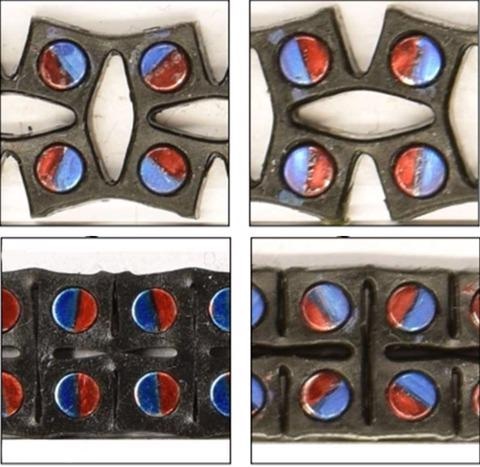Reviewed by Alex SmithFeb 3 2022
At the University of Massachusetts Amherst (UMass Amherst), a research group has recently announced that they have designed a new rubber-like solid substance that exhibits surprising qualities.
 The elastic material with embedded magnets whose poles are color-coded red and blue. Orienting the magnets in different directions changes the metamaterial’s response. Image Credit: UMass Amherst.
The elastic material with embedded magnets whose poles are color-coded red and blue. Orienting the magnets in different directions changes the metamaterial’s response. Image Credit: UMass Amherst.
The study has been reported in the journal Proceedings of the National Academy of Sciences.
The substance has the potential to absorb and discharge huge quantities of energy and can be programmed. The new material exhibits great promise for a highly extensive range of applications, from allowing robots to have more power without making use of additional energy to new helmets and safety materials that can dissipate energy much more rapidly.
Imagine a rubber band. You pull it back, and when you let it go, it flies across the room. Now imagine a super rubber band. When you stretch it past a certain point, you activate extra energy stored in the material. When you let this rubber band go, it flies for a mile.
Alfred Crosby, Study Senior Author and Professor, Polymer Science and Engineering, University of Massachusetts Amherst
This hypothetical rubber band is composed of a new metamaterial—a substance that has been engineered to have a property that is not found in naturally occurring materials—that integrates an elastic and rubber-like substance having small magnets fixed in it.
This new so-called 'elasto-magnetic' material takes profit of a physical property called a phase shift to considerably amplify the amount of energy that the material can either release or absorb.
A phase shift takes place when there is movement of material from one state to another: imagine water turning into steam or liquid concrete stiffening into a sidewalk. Whenever a shift in the material phase is found, energy is either liberated or absorbed.
Phase shifts are not just restricted to changes between liquid, solid, and gaseous states—a shift could even take place from one solid phase to another. A phase shift that discharges energy could be harnessed as a power source. However, getting sufficient energy has always been the hardest part.
“To amplify energy release or absorption, you have to engineer a new structure at the molecular or even atomic level,” states Crosby. But, this is difficult to do and even harder to do in a predictable method. However, Crosby confirms the feasibility with the use of metamaterials and says as follows:
We have overcome these challenges, and have not only made new materials, but also developed the design algorithms that allow these materials to be programmed with specific responses, making them predictable.
Alfred Crosby, Study Senior Author and Professor, Polymer Science and Engineering, University of Massachusetts Amherst
The researchers have gained inspiration from a few of the lightning-quick responses observed in nature: the snapping-shut of Venus flytraps and trap-jaw ants.
We’ve taken this to the next level. By embedding tiny magnets into the elastic material, we can control the phase transitions of this metamaterial. And because the phase shift is predictable and repeatable, we can engineer the metamaterial to do exactly what we want it to do: either absorbing the energy from a large impact, or releasing great quantities of energy for explosive movement.
Xudong Liang, Study Lead Author and Professor, Harbin Institute of Technology
Xudong Liang, the study lead author is currently a professor at Harbin Institute of Technology, Shenzhen (HITSZ) in China who completed this study while a postdoc at UMass Amherst.
This study was financially supported by the US Army Research Laboratory and the US Army Research Office as well as Harbin Institute of Technology, Shenzhen (HITSZ), and has applications in any scenario where either lightning-quick responses or high-force impacts are required.
Journal Reference:
Liang, X., et al. (2022) Phase-transforming metamaterial with magnetic interactions. Proceedings of the National Academy of Sciences. doi.org/10.1073/pnas.2118161119.